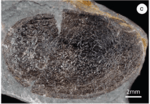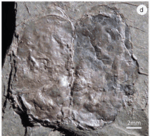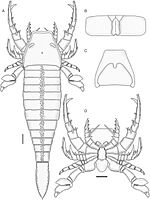Winneshiek Shale facts for kids
Quick facts for kids Winneshiek ShaleStratigraphic range: Darriwilian |
|
|---|---|
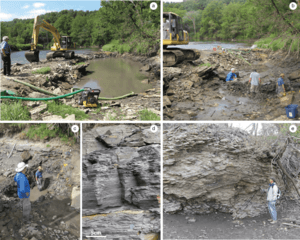
Winneshiek Shale strata exposed via a temporary dam (a-d)
|
|
| Type | Formation |
| Underlies | St. Peter Sandstone |
| Overlies | unnamed breccia unit |
| Thickness | 38 m |
| Lithology | |
| Primary | shale |
| Location | |
| Region | Upper Midwest |
| Country | United States |
| Extent | Iowa |
| Type section | |
| Named for | Winneshiek County, Iowa |
| Named by | Liu et al., 2006 (as "Winneshiek Lagerstätte") |
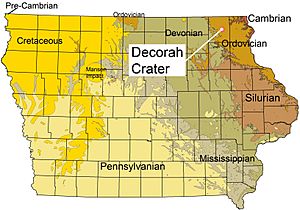 Location of the Decorah crater in Iowa, the only area where the Winneshiek Shale is found |
|
The Winneshiek Shale is a special rock layer found in Iowa, USA. It formed during the Ordovician period, about 460 million years ago. This rock layer is famous for its incredibly well-preserved fossils, which tell us about an ancient ocean ecosystem.
Scientists first found the Winneshiek Shale in 2005. It's unique because it's only found inside a giant bowl-shaped hole in the ground called the Decorah crater. This crater was made by a meteorite hitting the Earth a very long time ago. The fossils in the shale include some of the oldest known sea scorpions, like Pentecopterus, and huge conodonts (eel-like creatures) such as Iowagnathus.
Contents
What is the Winneshiek Shale?
The Winneshiek Shale is a thin layer of dark gray to greenish-brown shale. Shale is a type of rock made from mud and clay that has been pressed together over millions of years. This rock layer can be up to 38 meters (about 125 feet) thick, but in most places, it's thinner, around 18-27 meters (60-90 feet).
This special shale is only found inside the Decorah crater, which is about 5.6 kilometers (3.5 miles) wide. The crater was formed when a large space rock crashed into Earth. The Winneshiek Shale sits on top of a thick layer of broken rock from this impact. It is also found below another rock layer called the St. Peter Sandstone.
Scientists mostly study the shale using drill cores, which are long samples of rock taken from deep underground. You can also see small parts of the shale along the Upper Iowa River. In 2010, a temporary dam helped scientists collect many fossils from a 4-meter section of the shale.
How Fossils are Preserved
The fossils in the Winneshiek Shale are usually preserved as hard shells or thin carbon films. This means that the soft parts of the animals usually didn't survive. However, some amazing discoveries have been made! For example, some Ceratiocaris specimens (a type of ancient crustacean) have fossilized gut contents. This means we can see what they ate! Also, some soft bromalites (fossilized poop) are preserved, giving clues about the diet of ancient creatures.
Scientists believe the Winneshiek Shale formed in a calm, deep part of the ocean or an estuary (where a river meets the sea). The bottom of this ancient water body likely had very little oxygen and was a bit acidic. These conditions helped to preserve the fossils so well.
When Did the Winneshiek Shale Form?
It's tricky to figure out the exact age of the Winneshiek Shale. There isn't much radiometric dating (a way to date rocks using radioactive elements) available for it. Also, it doesn't share many types of fossils with other nearby rock layers that have known ages.
However, scientists know that the rock layer above it, the St. Peter Sandstone, is from the late Darriwilian age. The Winneshiek Shale contains some conodont fossils, like Multioistodus subdentatus and Archeognathus primus, which are also found in other rocks from the mid- to upper-Darriwilian age in Missouri. This helps scientists estimate its age.
Scientists also look at chemical clues in the rocks, like the amount of different carbon isotopes. These clues suggest that the Winneshiek Shale formed during a time when carbon levels in the ocean were changing worldwide. This period might also be linked to the "Ordovician meteor event", a time when many asteroids crashed into Earth. This event could even be connected to the "Great Ordovician Biodiversification Event" (GOBE), a huge increase in the variety of life on Earth during the mid-Ordovician.
Amazing Ancient Life: The Winneshiek Biota
The fossils found in the Winneshiek Shale are called the Winneshiek biota. They are very different from most other Ordovician fossil sites. Usually, you find many fossils of animals that lived on the seabed, like trilobites (ancient sea bugs), echinoderms (like starfish), or corals. But in the Winneshiek Shale, there are very few of these.
Instead, most of the fossils are from animals that swam in the open water (called nektonic animals) or swam close to the seabed (called nektobenthic animals). The most common fossils are conodont elements (parts of eel-like creatures) and bromalites (fossilized poop). Some of the bromalites even contain conodont elements, suggesting that sea scorpions or larger conodonts made them.
Other fossils found include:
- Different types of crustaceans (like crabs and shrimp).
- Algae (ancient sea plants).
- A type of brachiopod (shellfish) called a linguloid.
- One fossil of a gastropod (a type of snail).
- Head shields from armored agnathans (jawless fish).
Arthropods
Color key
|
Notes Uncertain or tentative taxa are in small text; |
| Arthropods of the Winneshiek Shale | ||
|---|---|---|
| Taxon | Notes | Images |
| Ceratiocaris winneshiekensis | A common phyllocaridan crustacean, one of the oldest ceratiocaridids | |
| Crustacea indet. | An unknown bivalved crustacean, possibly a notostracan or Douglasocaris-like crustacean | |
| Decoracaris hildebrandi | A large bivalved crustacean, possibly the oldest known thylacocephalan | |
| Iosuperstes collisionis | An unknown bivalved crustacean | |
| Leperditiidae? indet. | An unknown bivalved crustacean, possibly a leperditiid leperditicopidan | |
| cf. Lomatopisthia | A palaeocopidan ostracod (a tiny crustacean with a shell) | |
| Palaeocopida indet. | An unknown palaeocopidan ostracod | |
| Pentecopterus decorahensis | The oldest known megalograptid eurypterid (sea scorpion) | |
| Podocopida indet. | An unknown podocopidan ostracod | |
| Winneshiekia youngae | A dekatriatan euchelicerate similar to eurypterids and chasmataspidids | |
Chordates
| Chordates of the Winneshiek Shale | ||
|---|---|---|
| Taxon | Notes | Images |
| Archeognathus primus | A common giant archeognathid conodont (an eel-like creature) | |
| Astraspis sp. | An armored agnathan (jawless fish) | |
| Conodonta indet. | Multiple unnamed or undescribed conodont types | |
| Iowagnathus grandis | A common giant iowagnathid conodont | |
| Multioistodus subdentatus | A conodont | |
Other Organisms
| Other organisms of the Winneshiek Shale | ||
|---|---|---|
| Taxon | Notes | Images |
| Cladophorales indet. | An unnamed large-celled filamentous algae, similar to Cladophora | |
| Gastropoda indet. | An unknown gastropod (snail) | |
| Linguloidea indet. | An unknown linguloid brachiopod (a type of shellfish) | |



